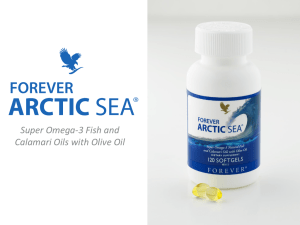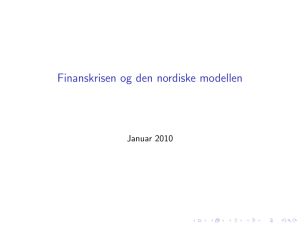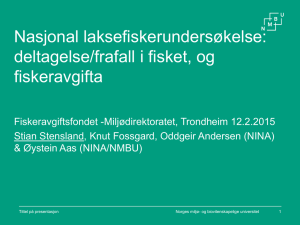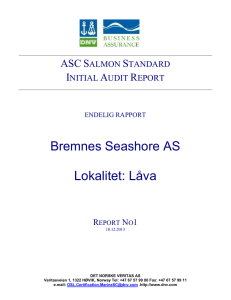Alf-Helge Aarskog - Leading the blue revolution.pdf
advertisement
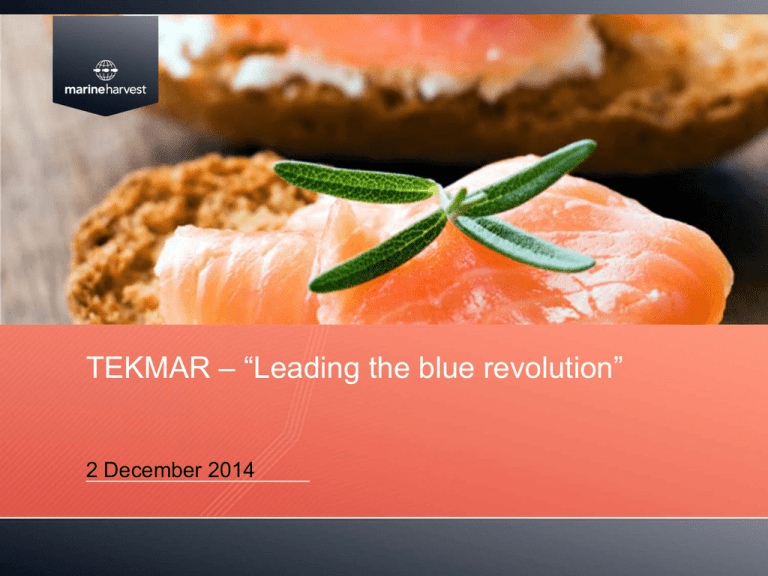
TEKMAR – “Leading the blue revolution” 2 December 2014 Can we produce food in the ocean? 70 % of the surface 2% of the food production « Leading the blue revolution» Healthy and tasty food 2 Energy efficient and low emission food production Increasing population needs new solutions The responsible choice for the environment… QUANTITY OF FEED FED CARBON EMISSION FRESH WATER CONSUMPTION 3 …for your body… Proteins: High quality, easy digestable proteins Omega-3: High content of Omega-3 fatty acids Vitamins: Rich in A, D and B12 vitamins Mineral: High content of iodine & selen, taurin and sterols 4 …and it’s tasty! AMERICAS Note: Examples of consumer products and branding initiatives from Marine Harvest EUROPE ASIA 5 Biological carrying capacity diminishes growth 2 500 10 CAGR 2.9% 9 8 EBIT per kg (NOK) Global harvest (thousand tonnes) 2 000 CAGR 6.6% 1 500 1 000 7 6 5 4 CAGR 9.6% 3 500 2 1 0 1996 2005 2014 2020 0 1996-2005 (1) 2006-2014 (2) 2015-2020 Source: Kontali (3) Notes: (1) Average EBIT per kg for the Norwegian industry (Source: Kontail - The Salmon Farming Industry in Norway) (2) Average EBIT per kg for Marine Harvest in Norway (3) Marine Harvest does not provide guidance on industry supply beyond 2015 6 Marine Harvest business areas Position 220 thousand tonnes vs global production of ~2.6m 414 thousand tonnes vs global production of 2.0m (21%)(1) Global sales network Leading position in VAP Focus areas Successful construction and implementation by 2014 Acquisitive growth in Norway and Chile Integration of Morpol Restructuring programme in VAP Organic growth in VAP Note: (1) Based on 2014 HOG tonnes 7 Potensial i følge DKNVS og NTVA – Verdiskaping basert på produktive hav i 2050 rapport 2012 2% in 2015 – 5 % harvest growth per year from 2016, with today’s MAB regime Growth – Atlantic salmon in Norway achievable? 7 6 5 4 3 2 1 0 2010 2014 2015 2020 2030 2040 2050 Notes: For illustrative purposes only, based on MHG estimates for 2014 and 2015, and illustrative 5 % growth in harvestvolume per year until 2050 9 Challenges to be solved? › What prevents the industry from growing and achieving 2050 potential? • Sea lice • EPA/DHA • Access to suitable area for farming • Predictable regulations 10 Hovedutfordring er lakselus – tall fra folkehelseinstituttet 14 000 Andre medikamenter (kg) 12 000 hydrogen-peroksid (tonn) 10 000 8 000 6 000 4 000 2 000 0 2004 2014 estimert fra 2013-tall av MH 2005 2006 2007 2008 2009 2010 2011 2012 2013 2014 (Est) 11 Case study: Lusestrategi i Agder 2009 - 2014 12 Kjønnsmoden lakselus – status MH Agder 13 Den gode sirkel Mindre behandling Rensefisk 1486 Rene nøter og utstyr Riktig strategi Rensestasjon 14 New national strategy needs to be developed and implemented › Reduce lice pressure • To allow cleaner fish to do as much as possible of the job • To reduce need for chemical treatments and further resistance development › Approached by › Avoiding high gravid levels › Area management and focus › 0 gravid female approach on pen level? › Treat if required and within time › Applying non medicine approach- to reduce lice pressure or for treatments › Coordination and discipline › Focus on broodstock facilities › Focus on implementing best practice › Nobody will succeed on their own - if not controlling big areas. 15 Fish Oil Availability Assumptions: • Projected growth rate for salmonid feed of 3% per year from 2014 onwards • Growing demand from the omega-3 capsule industry of 10% per year • 20% EPA+DHA/ fish oil in an average fish oil • 31% added oil in salmon feed containing 7.5, 5 and 3% EPA+DHA of fat Insights: • Fish oil demand may exceed supply in 2015 at 7.5% EPA+DHA of fat in the added oil of salmonid feed OR … in 2019 at 5% • OR … in 2021 at 3%. • Source: EWOS Sourcing Alternative Sources Algae Fermentation GMO Forutsigbar regulering – nyttig for videre vekst 18 Naturgitte forutsetninger for å lykkes 90 000 km2 sjøareal En fantastisk mulighet 19 Svært begrenset arealbruk Rogaland fylke Kamøy Arealbeslag samlet havbruk vs jordbruk i Norge › Havbruk*: 200 km2 (=Karmøy) › Jordbruk: 10 200 km2 (= Rogaland) 0,06 promille av tilgjengelig sjøareal * Inkludert fiskeforbudssone. Anleggene alene utgjør kun 60 km2 20 Hvordan sikre areal? › Kommuner må sikre areal for fremtidig produksjonsvekst gjennom enda bedre reguleringsplaner › Vi må se på oppdrett i utilgjengelige områder, og hvordan dette kan gjøres tilgjengelig › Kommuner som legger til rette for oppdrett må få noe igjen for det • Avgift gjennom tildeling av ny MTB må i større grad tildeles kommuner • Nye lokaliteter må kompenseres ved engangsbeløp › Fylkeskommuner og fiskeridepartement må kunne legge føringer for for å sikre helhetlig utvikling. 21 The “Prada” of seafood in emerging markets 22 Out concepts stores in Taiwan are gaining popularity and driving consumer awareness 23 Mowi brand name and concept positioning in Asia Mowi - Marine Harvest’s own superior breeding programme - Based on the famous Vosso salmon - Supreme strength and size - Sustainably developed by natural selection - Supreme quality with unique colour guarantee • “Stronger, healthier and tastier salmon” Mowi video: https://vimeo.com/106263933 24
